Chapter 10 - Reaching the Age of Adolescence
Multiple Choice Questions
Question 1: The belief that the mother is completely responsible for the sex of the child is wrong because the child
a) gets sex chromosome only from the mother.
b) develops in the body of the mother.
c) gets one sex chromosome from the mother and the other from the father.
d) gets sex chromosome only from the father.
Answer: c) gets one sex chromosome from the mother and the other from the father.
Question 2: AIDS can spread from an infected person to another person through
a) sharing food
b) blood transfusion
c) sharing comb
d) a mosquito bite
Answer: b) blood transfusion
Question 3: Given below are events that lead to pregnancy and development of embryo.
i) Fertilization of egg
ii) Maturation of egg
iii) Release of egg
iv) Embedding of embryo in thickened uterine wall.
Which of the following options gives the correct order of sequence in which they occur?
a) i, ii, iii, iv
b) ii, i, iii, iv
c) i, iv, ii, iii
d) ii, iii, i, iv
Answer: d) ii, iii, i, iv
Question 4: For the metamorphosis of tadpoles which of the following elements must be available in water?
a) chlorine
b) carbon
c) sulphur
d) iodine
Answer: d) iodine
Question 5: The most conspicuous visible change that occurs in boys during puberty is:
a) development in voice box.
b) increase in height.
c) production of sperms.
d) increased sweating.
Answer: b) increase in height.
Question 6: Structures present in a cell which is responsible for determination of the sex of a baby is
a) cytoplasm
c) nucleus
b) cell membrane
d) chromosomes
Answer: d) chromosomes
Very Short Answer Questions
Question 7: Unscramble the underlined words in the following sentences.
a) Reproductive life of a woman lasts from hacreemn to spauoemen.
b) The development of a caterpillar to an adult butterfly is termed as poommertaissh.
c) The overgrowth of sumselc in xalnyr leads to the hoarse voice in adolescent boys.
d) Dannalier helps the body to adjust and fight the stress.
Answer:
a) Reproductive life of a woman lasts from menarche to menopause.
b) The development of a caterpillar to an adult butterfly is termed as metamorphosis.
c) The overgrowth of muscle in larynx leads to the hoarse voice in adolescent boys.
d) Adrenalin helps the body to adjust and fight the stress.
Question 8: Complete the following sentences.
a) In females, the uterine wall thickens to receive the __________.
b) Endocrine glands release hormones directly into ___________ for transportation to the __________.
c) The sex hormones, _______________________ and estrogen are responsible for the development of __________ characters.
d) Release of sex hormones is under the control of a hormone secreted from the __________.
Answer:
a) In females, the uterine wall thickens to receive the fertilised egg.
b) Endocrine glands release hormones directly into blood stream for transportation to the target site.
c) The sex hormones, testosterone and estrogen are responsible for the development of secondary sexual characters.
d) Release of sex hormones is under the control of a hormone secreted from the pituitary gland.
Question 9: Give a suitable word for each of the following statements.
a) The site which responds to a hormone.
b) Name of a gland which transports secretions through ducts.
c) Chemicals which control changes at adolescence stage.
d) It marks the beginning of reproductive period.
Answer:
a) Target site
b) Sweat glands
c) Hormones
d) Puberty
Question 10: Name the hormone that is released by testes at the onset of puberty.
Answer: The hormone released by testes at the onset of puberty is testosterone.
Question 11: Name the female hormone produced by ovaries that helps in development of mammary glands.
Answer: The female hormone produced by ovaries that help in development of mammary glands is estrogen.
Short Answer Questions
Question 12: Match the hormones given in Column A with their deficiency disease given in Column B.
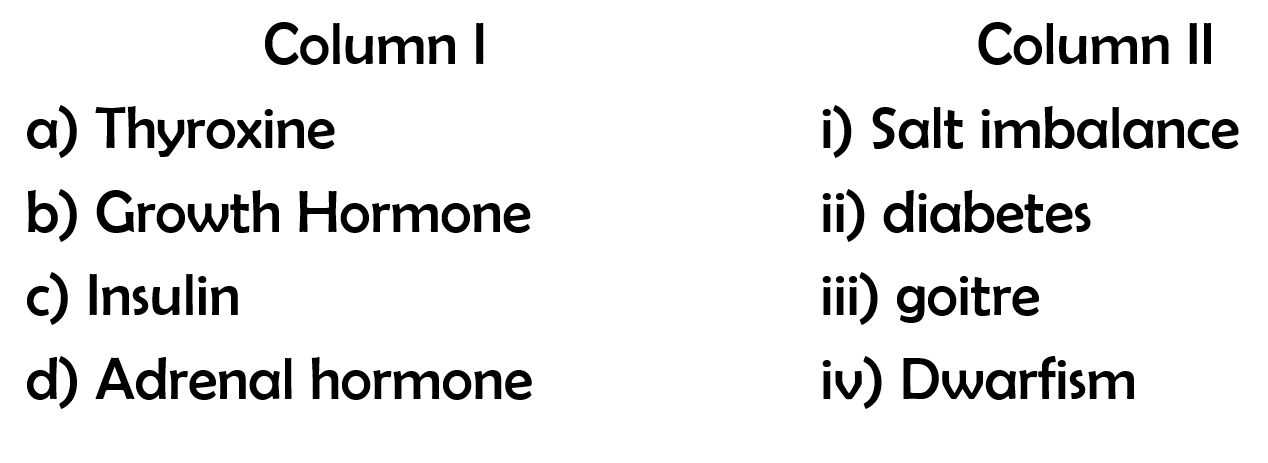
Answer:

Question 13: Lila always eats only dal and rice in every meal. She often falls ill and has become prone to diseases. Can you suggest changes in her diet which can make her healthy and free from disease?
Answer: Lila only eats dal and rice in every meal which only consists of carbohydrates and proteins in major portion in comparison to other components of food which doesn’t contain complete balanced diet. If we don’t take complete balanced diet, we will become ill and prone to diseases. Lila should have sufficient amount of Vitamins, Minerals, fats, Dietary fibre in order to stay healthy and free from diseases.
Question 14: Mention any two features each that are seen in boys and girls each to distinguish them from each other at puberty.
Answer: The 2 features that are seen in boys and girls to distinguish them from each other at puberty are
• Boys
→ Growth of facial hairs
→ Voice becomes hoarse
• Girls
→ Breast develop
→ Region below waist become wider
Question 15: We should avoid taking medicines/drugs unless prescribed by a doctor. Give reasons.
Answer: Several medicines have adverse side effects and have specific dosage levels which if not followed may harm the body. Drugs can be addictive too and can ruin our health and happiness.
Question 16: A few of Paheli’s classmates eat potato chips and burgers regularly during the recess at school. Are they healthy eating habits? Give reasons.
Answer: No, what Paheli’s classmate did during recess at school was totally not a healthy eating habit. This is because the potato chips and burgers have very low nutrition value and they are not much healthy.
Question 17: Read the statements given below and fill up the blanks with the correct words listed in the box.
deep, ductless, nutrients, thyroxine
a) The meal that includes all __________ is a balanced diet.
b) Insufficient production of __________ in the tadpoles leads to their incomplete development.
c) Endocrine glands are also called __________ glands.
d) After attaining puberty boys develop a __________ voice.
Answer:
a) The meal that includes all nutrition is a balanced diet.
b) Insufficient production of thyroxine in the tadpoles leads to their incomplete development.
c) Endocrine glands are also called ductless glands.
d) After attaining puberty boys develop a deep voice.
Question 18: Fill the blank circles in figure 10.1 and identify the sex of child A and B.
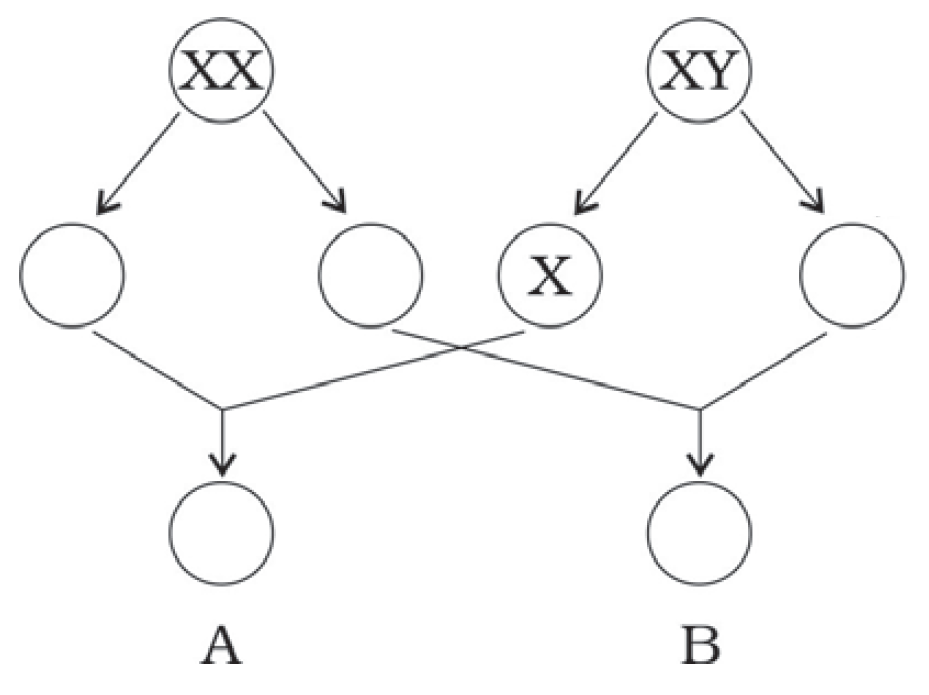
Answer:

Long Answer Questions
Question 19: During adolescence, the body of boys and girls undergoes certain changes. Given below are a few of those changes.
a) Broad shoulders
b) Wider chests
c) Wider region below waist
d) Development of muscles
e) Development of mammary glands
f) Growth of facial hair
g) Acne and pimples on face
h) Development of sex organs
i) High-pitched voice
j) Growth of pubic hair.
Categorise these changes into those that occur in boys and those that occur in girls and fill in the table given below.
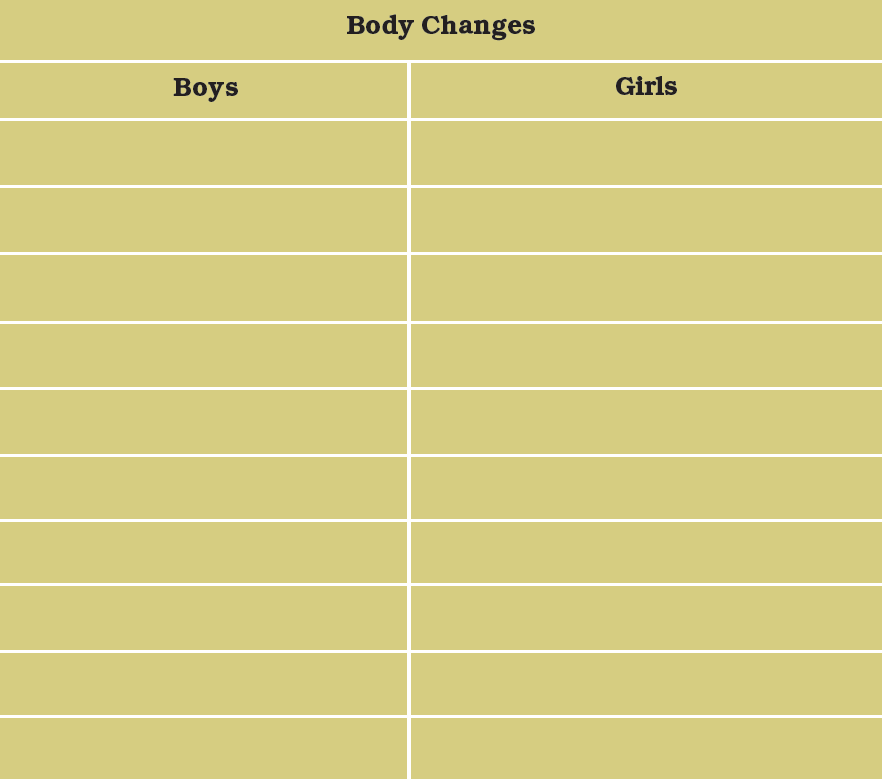
Answer:

Question 20: In Fig.10.2 mark the positions of the endocrine glands which release the hormones that:
a) controls the release of sex hormones.
b) is responsible for the secondary sexual characters in boys.
c) prevents diabetes.
d) maintains the correct salt balance in the blood.

Answer:
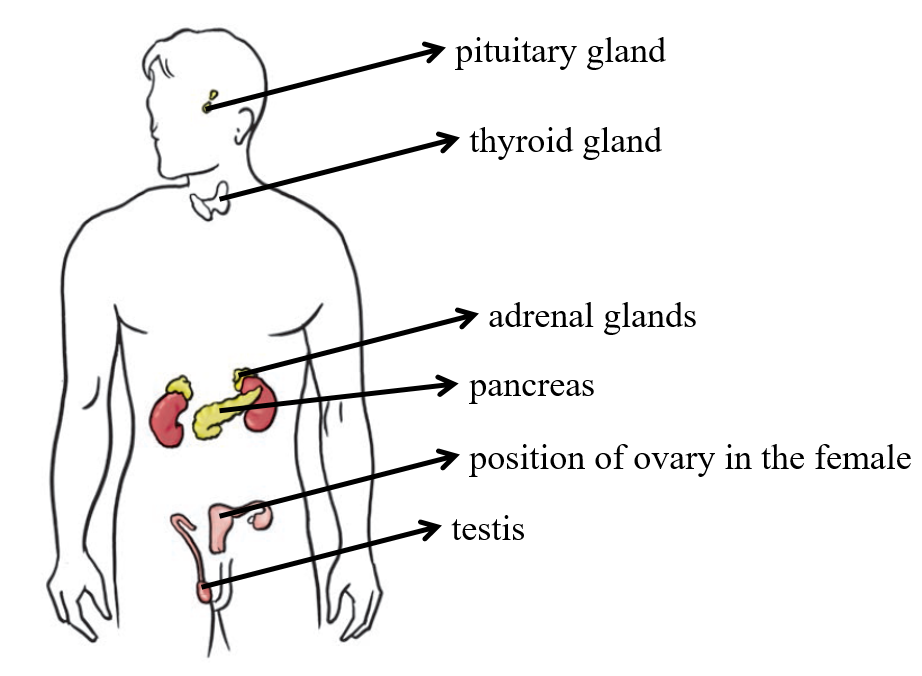
Question 21: Given below are certain food items required for proper nourishment of adolescents. Name the nutrients present in the food items and write their functions.
Answer:
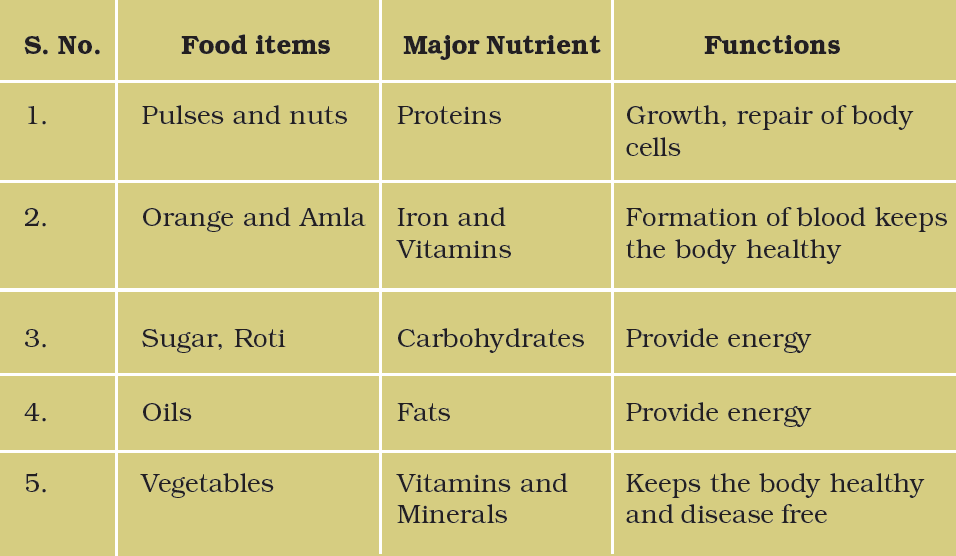
Question 22: Name the hormone which would be released during the following situations:
a) a frightened person.
b) growth of a child to adult.
c) development of caterpillar to moth.
d) development of tadpole to frog.
Answer:
a) Adrenaline
b) Growth hormone
c) Insect hormone
d) Thyroxine
Question 23: In human females, each time during maturation and release of egg the inner wall of uterus thickens. Is this thickening permanent? Give reasons.
Answer: No, this thickening of the uterine wall is not permanent. If the egg gets fertilised, it starts developing and gets embedded in the uterine wall resulting in pregnancy. During pregnancy no more eggs are released and the thickened lining is discharged only when the baby is born. However, if fertilisation does not occur, the released egg and the thickened lining are shed off resulting in menstruation.
Question 24: John and Radha were classmates since childhood. When Radha became eleven years old, she developed a little swelling on her neck. She visited the doctor who started medication for her. After a few years, John also developed a slight protrusion on his throat. He got worried and went to the doctor. But, the doctor assured him that it was a normal feature in boys while they are growing up. Can you think of any reasons for the difference in diagnoses?
Answer: The swelling on the neck of Radha may have been because of goitre in which her thyroid gland was producing insufficient quantity of thyroxine. However, the protrusion in John’s throat would be Adam’s apple, a result of growth of voice box in adolescent boys.
Question 25: Observe the chart and graph given in Fig. 10.3 carefully and answer the following questions.
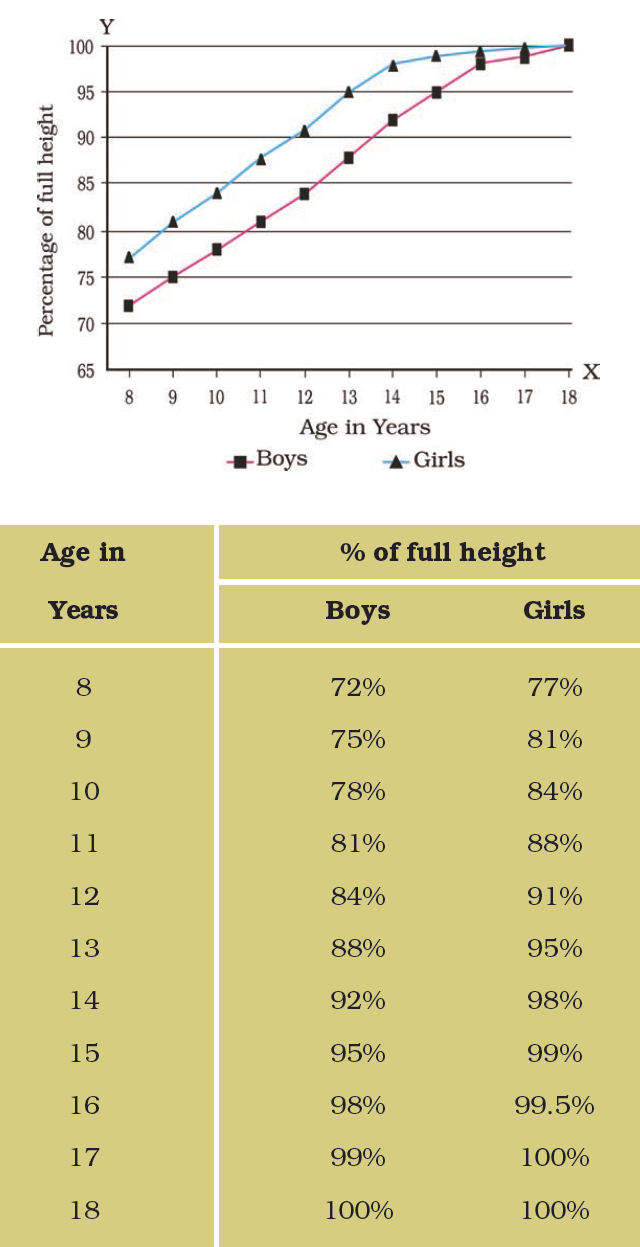
a) Which of the line represents the height of boys?
b) Which line represents the height of girls?
c) What is the difference between the pattern of increase in the height of boys and girls?
d) Is this pattern true for each individual?
Answer:
a) The red line represents the height of boys.
b) The blue line represents the height of girls.
c) At the onset of puberty, girls grow faster in height than the boys and by the age of 18 years, approximately both reach their maximum height.
d) No, the rate of growth in height varies among individuals. Some may grow in height suddenly at puberty and then slow down, while others may grow gradually.
Question 26: Salma had a very soft and smooth skin during her childhood. As she entered adolescence, she developed pimples on her face. The skin specialist advised her to wash her face at regular intervals. Can you explain the reasons for the appearance of pimples on her face and suggest ways to prevent them?
Answer: During adolescence, the secretion of sweat glands and sebaceous glands increases leading to formation of acne and pimples. Regular face wash keeps the face clean and dry and helps to reduce the pimples.
Question 27: Our government has legalised the age for marriage in boys and girls. Give reasons as to why one should get married after a certain age.
Answer: In our country, the legal age for marriage is 18 years for girls and 21 years for boys. This is because teenage mothers are not prepared mentally or physically for motherhood. Early marriage and motherhood causes health problems in both mother and the child. It also curtails employment opportunities for the young woman and may cause mental agony as she is not ready to shoulder responsibilities of motherhood. Also, the boys before that age may not be mentally matured and financially secure enough to take on the responsibilities of a family.
Question 28: It is believed that height of a child depends upon the genes inherited from parents. However, it is often seen that tall parents may have short children and vice-versa. Are there factors other than genes, that can cause these variations?
Answer: Yes, though the height of a child depends upon genes inherited from a parent there are various factors which affect the height of a child like balanced diet, exercise, hormones, etc. If a child is not able to get proper nutrients from his balanced diet then it will affect his/her growth and development because many nutrients help in the building strong bones, muscles, etc. Similarly, if growth hormone is not properly secreted by pituitary gland it may cause stunted growth (dwarfism) or over growth (gigantism) in children. Proper and regular exercise is required for healthy bones and muscles development.

No comments:
Post a Comment